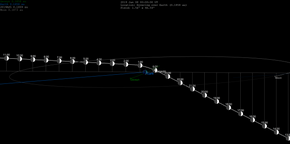2019 AS5
Appearance
 The hourly motion of2019 AS5passed the Earth between 7 and 8 January 2019 | |
| Discovery | |
|---|---|
| Discovery site | Mount Lemmon Obs. |
| Discovery date | 8 January 2019 |
| Designations | |
| 2019 AS5 | |
| NEO·Apollo [1] | |
| Orbital characteristics [1] | |
| Epoch27 April 2019 (JD2458600.5) | |
| Uncertainty parameter5 | |
| Observation arc | 1 day |
| Aphelion | 1.8769AU |
| Perihelion | 0.8188 AU |
| 1.3478 AU | |
| Eccentricity | 0.3925 |
| 1.56yr(571.547 d) | |
| 98.81126° | |
| 0° 37m47.528s/ day | |
| Inclination | 0.7012968° |
| 106.7463° | |
| 294.359° | |
| EarthMOID | 0.000140 AU (0.054LD) |
| Physical characteristics | |
| 1–2m(3.3–6.6ft) | |
| 32.243[1] | |
2019 AS5is anear-Earth asteroidthat passed close by the Earth on 8 January 2019. It passed within 0.04lunar distancesor 15,000 kilometers of the center of the Earth, 8600 km from the surface. It was discovered by theMt. Lemmon Survey9 hours after closest approach. It is estimated to be about 1–2 metres (3–7 feet) in diameter.[2]
As of July 2019[update],it is the closest approach of a non-impacting asteroid in 2019.[3]2019 MOimpacted Earth on 22 June 2019.
See also
[edit]References
[edit]- ^abc"JPL Small-Body Database Browser: (2019 AS5)"(2019-01-08 last obs.).Jet Propulsion Laboratory.Retrieved9 January2019.
- ^Asteroid 2019 AS5 flew past Earth at a very close distance of 0.04 LD
- ^Go tohttps://cneos.jpl.nasa.gov/ca/and for Table Settings select "Past (within a year)" and sort by "CA distance nominal"
External links
[edit]- MPEC 2019-A128: 2019 AS5,Minor Planet Electronic Circular
- 2019 AS5atNeoDyS-2, Near Earth Objects—Dynamic Site
- 2019 AS5atESA–space situational awareness
- 2019 AS5at theJPL Small-Body Database
